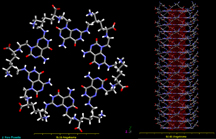Self-assembling nanotubes offer promise for future artificial joints
April 12, 2004 | Source: KurzweilAI
Researchers have discovered that bone cells called osteoblasts attach better to nanotube-coated titanium than to conventional titanium used to make artificial joints.

Self-assembly of rosettes
Conventional titanium used in artificial joints has surface features on the scale of microns, causing the body to recognize them as foreign and prompting a rejection response. This eventually weakens the attachment of the implants and causes them to become loose and painful, requiring replacement surgery.
The nanometer-scale bumps mimic surface features of proteins and natural tissues, prompting cells to stick better and promoting the growth of new cells. Bone and other tissues adhere to artificial body parts by growing new cells that attach to the implants, so the experiments offer hope in developing longer lasting and more natural implants.
The researchers created the self-assembling structures by using DNA chemistry to make a series of molecules programmed to link in groups of six to form tiny rosette-shaped rings. Numerous rings then combine to create the rod-like nanotubes.